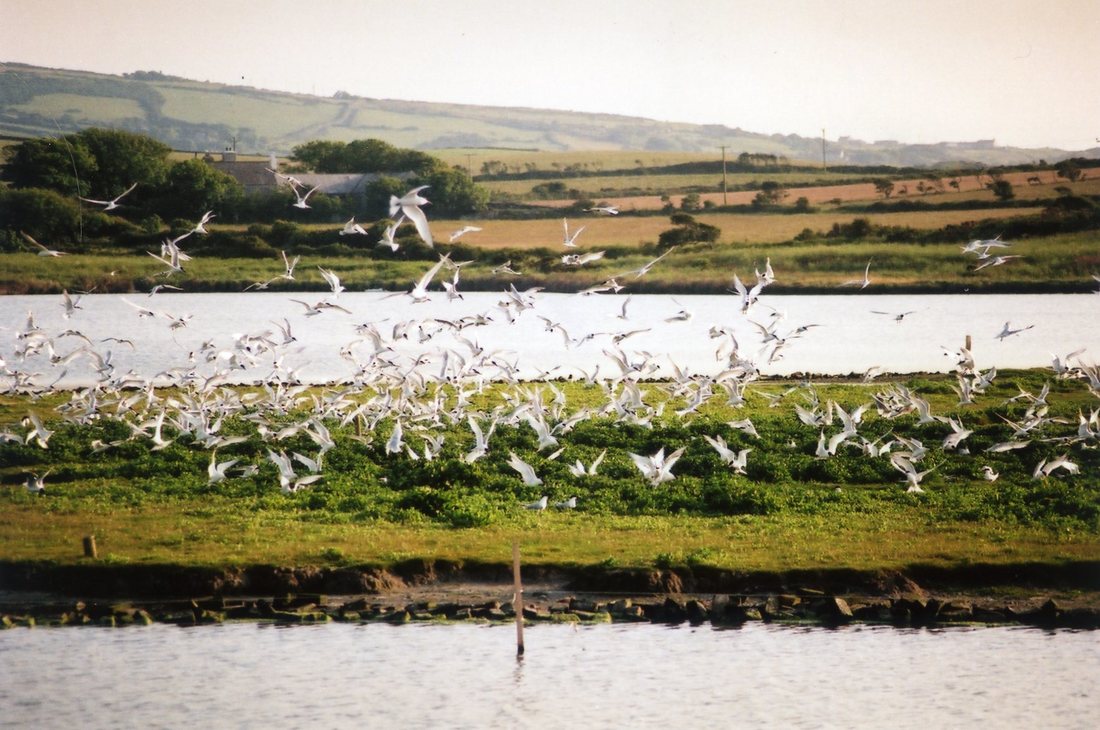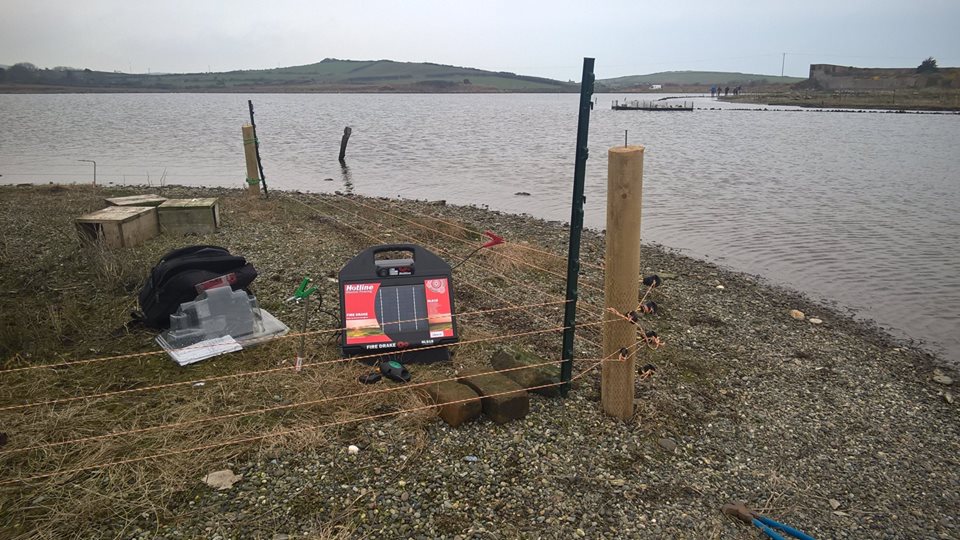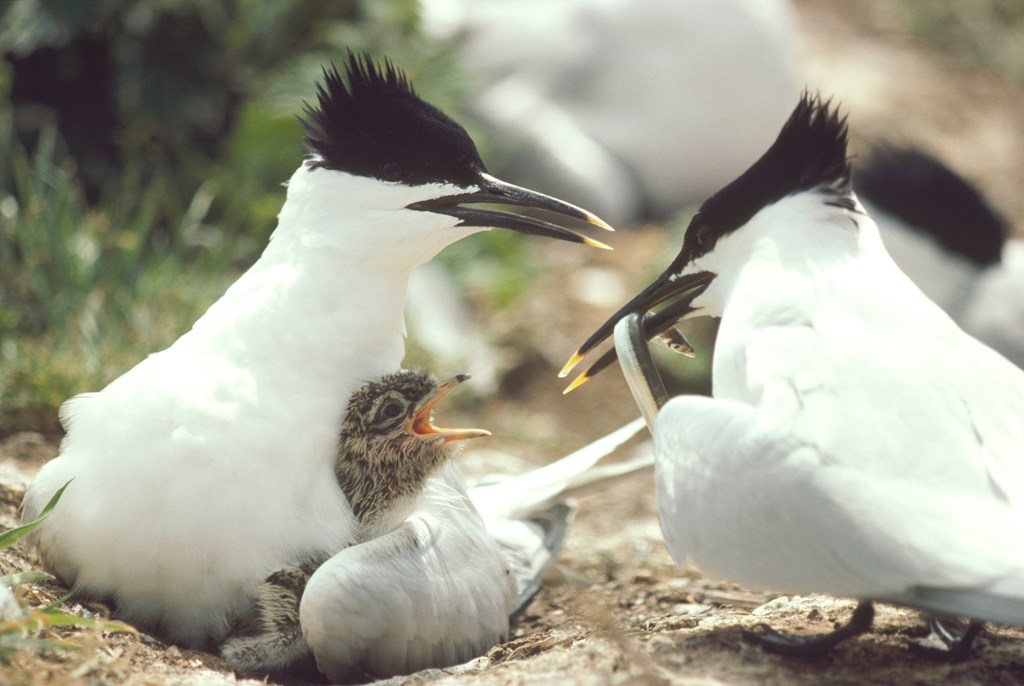|
It was once said that if you ‘buy a Sandwich Tern colony and make it into a nature reserve…they will probably repay you by nesting somewhere else the following year’. Rob Hume’s comments were telling. Between 2012 and 2016, the average breeding population of Sandwich Terns at Cemlyn was 2400 pairs of adult birds, raising nearly 1000 chicks each year. The Cemlyn Sandwiches are, or were, 20% of the UK population for Sandwich Terns and 3% of the whole world population. They were also the only Sandwich Tern colony in Wales. This year Cemlyn is relatively peaceful and the loud, discordant calls of ‘ERIC’ which normally announce the arrival of summer to northern Anglesey are quieter than usual. What’s happened? Sandwich Terns are the largest and heaviest of the British breeding species of terns but are, despite their size, fairly timid when defending their nests and react strongly to disturbance, predation and, it would seem to human eyes, mere whim. In 2017, the fast growth of the Sandwich Tern colony at Cemlyn, raised concerns that there might be competition for nesting space with Cemlyn’s other species of terns. Artificial rafts were put into place on Cemlyn’s lagoon to provide ‘overspill’ nesting sites for any Common and Arctic terns displaced by their larger cousins however, as it turned out, the additional nesting sites were not needed. The summer of 2017 saw a complete break in Sandwich Tern nesting due (mostly), to predation and disturbance by a family of otters and other disturbances; other species added further disturbance. Breeding failed and by early June of 2017, all the adult Sandwich Terns dispersed away from Cemlyn and northern Anglesey without raising young. Cemlyn is part of a European network of sites for birds and wildlife habitats; the Natura 2000 network. Each of these sites has a bespoke management plan aimed at protecting, conserving and building resilience for wildlife and natural habitats. For Cemlyn, the statutory management plan includes specific goals of providing nesting habitat for terns, whether or not they are present. In accordance with this management plan and the long term international goals of tern protection and management, early in 2018, the North Wales Wildlife Trust undertook a number of projects including building climate change resilience , predator ‘proofing’ for nesting habitats and non-lethal control of predators. This work was funded through the LIFE Programme of the European Union and the project ‘improving the conservation prospects of the priority species, the Roseate Tern, throughout its’ range in the UK and Ireland’. Despite these efforts and the creation of new and safer nesting habitat, 2018 has again been a truly remarkable year – but for the wrong reasons. This year, Sandwich Terns have returned to Cemlyn in much lower numbers and we’re not yet quite sure where these truly beautiful birds with the dreadful screechy voices might have gone, although Hodbarrow in Cumbia is having a bumper year. There are many factors that influence tern distribution and breeding success, not least being changing climate and weather around their breeding grounds in north-western Europe but also in their over-wintering territories in West Africa. The late winter of 2017/18 saw the arrival of the so called ‘Beast from the East’, a prolonged period of extreme cold across the UK. Whilst this cold would not have directly affected Sandwich terns that, at the time, would have still been in their winter quarters around the coasts of West Africa, the extreme cold and prevalence of northerly and easterly winds may have affected their northward migration as well as sea temperatures and fish distribution. Terns arriving in the UK after long and arduous migrations rely on sand eels to ‘refuel’ before breeding, present to their mates as incentives to breeding and ultimately- to feed young chicks. In the Spring of 2018, north easterly winds continued to dominate weather patterns and informal discussions with sea anglers and charter boat fishermen around Anglesey’s coasts reported an absence of sand eels in coastal areas as well as unusually cold water temperatures in April and May. It may be that as the summer progresses, the sand eels and small fish which form the basis of the terns’ feeding will return however, it may be too late to encourage large numbers of Sandwich Terns to settle and breed at Cemlyn this year. It is true that predator disturbance in 2017 probably led to the abandonment of nesting by all the three tern species which come to Cemlyn however, it would be simplistic to suggest that this predation had ‘caused’ the Sandwich Terns to avoid the site this year. North Wales Wildlife Trust has undertaken substantial works to deter predators and our summer wardens, Tim and Tarik, have reported that no otters have been seen on the lagoon islands this Spring.
Despite the troubles of 2017, Cemlyn has still attracted Sandwich, Common and Arctic Terns and in early June, a count indicated some 300 Sandwich Terns nests - 10% of previous years’ counts. The return and presence of terns and black headed gulls at represents some hope that the Cemlyn site, with its new and improved and ‘safer’ nesting habitat, is a worthwhile place to breed and raise young. To know whether 2018’s breeding season will be more successful than 2017 is a matter of waiting and watching.
0 Comments
Fe ddywedodd rhywun ryw dro ‘os prynwch chi boblogaeth o Fôr-wenoliaid Pigddu a chreu gwarchodfa natur ... mae’n bur debyg y byddan nhw’n talu’n ôl i chi’r flwyddyn ganlynol drwy nythu yn rhywle arall’. Roedd Rob Hume yn llygad ei le. Rhwng 2012 a 2016, roedd poblogaeth fagu’r Môr-wenoliaid Pigddu yng Nghemlyn yn 2400 o barau o oedolion ar gyfartaledd, gan fagu bron i 1000 o gywion bob blwyddyn. Môr-wenoliaid Cemlyn yw, neu oedd, 20% o boblogaeth y DU o Fôr-wenoliaid Pigddu, a 3% o holl boblogaeth y byd. Hefyd hon oedd yr unig boblogaeth o Fôr-wenoliaid Pigddu yng Nghymru. Eleni mae Cemlyn yn gymharol dawel ac mae’r gri uchel, ansoniarus, ‘ERIC’, oedd yn arfer cyhoeddi dyfodiad yr haf yng ngogledd Ynys Môn, yn dawelach nag arfer. Beth sydd wedi digwydd? Môr-wenoliaid Pigddu yw’r rhywogaeth fwyaf a thrymaf o’r rhywogaethau magu Prydeinig o fôr-wenoliaid ond, er gwaethaf eu maint, maent yn gymharol ddiniwed wrth amddiffyn eu nythod ac yn ymateb yn ddwys i aflonyddwch, ysglyfaethwyr ac, yn ôl pob tebyg i’r llygaid dynol, mympwy llwyr. Yn 2017, cododd twf cyflym y boblogaeth o Fôr-wenoliaid Pigddu yng Nghemlyn bryderon y byddai cystadleuaeth am ofod nythu yn erbyn rhywogaethau eraill Cemlyn o fôr-wenoliaid. Gosodwyd rafftiau artiffisial yn eu lle ar fôr-lyn Cemlyn fel lle ychwanegol ar gyfer safleoedd nythu unrhyw Fôr-wenoliaid Cyffredin neu Fôr-wenoliaid y Gogledd oedd yn colli’u lle i’w cefndryd mwy. Ond, fel y digwyddodd pethau, nid oedd angen y safleoedd nythu ychwanegol. Yn ystod haf 2017, ni fu unrhyw nythu gan y Môr-wenoliaid Pigddu a’r rheswm (pennaf) am hynny oedd ysglyfaethwyr, teulu o ddyfrgwn yn tarfu arnyn nhw, a tharfu o fath arall. Roedd rhywogaethau eraill yn ychwanegu at y tarfu. Ni lwyddodd y Môr-wenoliaid Pigddu i fagu ac erbyn dechrau mis Mehefin 2017, roeddent i gyd wedi gadael Cemlyn a gogledd Ynys Môn heb fagu cywion. Mae Cemlyn yn rhan o rwydwaith Ewropeaidd o safleoedd ar gyfer cynefinoedd adar a bywyd gwyllt; rhwydwaith Natura 2000. Mae gan bob un o’r safleoedd hyn gynllun rheoli pwrpasol i warchod, cadw a chreu cadernid ar gyfer bywyd gwyllt a chynefinoedd naturiol. Ar gyfer Cemlyn, mae’r cynllun rheoli statudol yn cynnwys nodau penodol o ran darparu cynefin nythu i fôr-wenoliaid, os ydynt yn bresennol ai peidio. Yn unol â’r cynllun rheoli yma a’r nodau rhyngwladol tymor hir ar gyfer gwarchod a rheoli môr-wenoliaid, yn gynnar yn 2018, aeth Ymddiriedolaeth Natur Gogledd Cymru ati i weithredu sawl prosiect, gan gynnwys creu gallu i wrthsefyll newid yn yr hinsawdd, gwarchod y cynefinoedd nythu rhag ysglyfaethwyr, a rheolaeth heb ladd ar ysglyfaethwyr. Cyllidwyd y gwaith yma drwy Raglen LIFE yr Undeb Ewropeaidd a’r prosiect ‘gwella rhagolygon cadwraeth y rhywogaeth flaenoriaeth, y Fôr-wennol Wridog, ledled ei hardaloedd yn y DU ac Iwerddon’. Er gwaetha’r ymdrechion hyn, ac er i gynefin nythu newydd, diogel gael ei greu, mae 2018 wedi bod yn flwyddyn nodedig – ond am y rhesymau anghywir. Eleni, mae llawer llai o Fôr-wenoliaid Pigddu wedi dychwelyd i Gemlyn ac nid ydym yn siŵr eto i ble mae’r adar eithriadol hardd yma a’u lleisiau sgrechllyd erchyll wedi mynd, ond mae Hodbarrow yn Cumbria yn cael blwyddyn arbennig o dda. Mae sawl ffactor yn gallu dylanwadu ar ddosbarthiad a llwyddiant magu môr-wenoliaid, ac yn sicr newid yn yr hinsawdd a’r tywydd o amgylch eu safleoedd magu yng ngogledd orllewin Ewrop, a hefyd eu tiriogaethau gaeafu yng Ngorllewin Affrica. Tua diwedd gaeaf 2017/18 fe ddaeth yr hyn oedd yn cael ei alw’n ‘Fwystfil y Dwyrain’ ar ymweliad â ni – cyfnod estynedig o dywydd oer iawn ledled y DU. Er na fyddai’r oerni yma wedi cael effaith uniongyrchol ar y Môr-wenoliaid Pigddu a fyddai, ar y pryd, dal ar eu tiroedd gaeafu o amgylch arfordir Gorllewin Affrica, efallai bod yr oerni eithafol a gwyntoedd gogleddol a dwyreiniol cryf wedi effeithio ar eu mudo tua’r gogledd, a hefyd ar dymheredd y môr a dosbarthiad pysgod. Mae môr-wenoliaid sy’n cyrraedd y DU ar ôl siwrnai faith a llafurus yn dibynnu ar lysywod y tywod fel tanwydd i’w hadfywio cyn magu, i’w cyflwyno i’w cymar fel cymhelliant i baru ac, yn y pen draw, i fwydo eu cywion ifanc. Yng Ngwanwyn 2018, roedd y gwyntoedd gogledd ddwyreiniol yn parhau i reoli’r patrymau tywydd ac wedi sgyrsiau anffurfiol gyda physgotwyr môr a physgotwyr cychod siarter o amgylch arfordir Môn, clywsom am absenoldeb llysywod y tywod mewn ardaloedd arfordirol, yn ogystal â thymheredd anghyffredin o oer yn y dŵr ym misoedd Ebrill a Mai. Efallai, wrth i’r haf fynd yn ei flaen, y daw llysywod y tywod a’r pysgod bach sy’n sail i ddeiet y môr-wenoliaid yn eu hôl. Er hynny, efallai y bydd yn rhy hwyr i annog niferoedd mawr o Fôr-wenoliaid Pigddu i setlo a magu yng Nghemlyn eleni. Mae’n wir bod tarfu gan ysglyfaethwyr yn 2017 wedi arwain mae’n bur debyg at y tair rhywogaeth o fôr-wenoliaid sy’n dod i Gemlyn yn gadael eu nythod. Er hynny, byddai’n simplistig awgrymu bod yr ysglyfaethwyr hyn wedi ‘achosi’ i’r Môr-wenoliaid Pigddu osgoi’r safle eleni. Mae Ymddiriedolaeth Natur Gogledd Cymru wedi gwneud gwaith sylweddol i atal ysglyfaethwyr ac mae’r wardeiniaid haf, Tim a Tarik, wedi dweud nad oes unrhyw ddyfrgwn wedi’u gweld ar ynysoedd y môr-lyn y Gwanwyn yma. Er gwaethaf anawsterau 2017, mae Cemlyn wedi llwyddo i ddenu Môr-wenoliaid Pigddu, Môr-wenoliaid Cyffredin a Môr-wenoliaid y Gogledd ac ar ddechrau mis Mehefin, wrth gyfrif, roedd tua 300 o nythod Môr-wenoliaid Pigddu - 10% o gyfrif y flwyddyn flaenorol. Mae dychweliad a phresenoldeb y môr-wenoliaid a’r gwylanod penddu’n rhoi rhyw obaith bod safle Cemlyn, gyda’i gynefin nythu newydd, gwell a ‘diogelach’, yn lle gwerth chweil i baru a magu cywion ifanc.
Bydd rhaid aros a gwylio i weld a fydd tymor magu 2018 yn fwy llwyddiannus nag un 2017. |
More Blogs to Read
AuthorThis blog is maintained by various people from the project team. Archives
August 2020
Categories
All
|
Roseate Tern LIFE Project is supported by the LIFE Programme of the European Union
LIFE14 NAT/UK/000394 ROSEATE TERN
LIFE14 NAT/UK/000394 ROSEATE TERN









 RSS Feed
RSS Feed